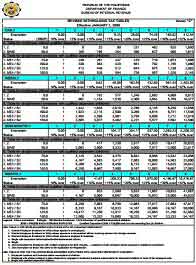As we know it, employers are basically required to deduct and withhold tax from the compensation or salary they pay to their employees. When computing for the withholding tax on compensation income, the following methods are prescribed by the BIR Revenue Regulations No. 10-2008.
1. Use of withholding tax table. The use of the Revised Withholding Tax Tables is the general method used for computing tax withheld on compensation. The following are the four withholding tax tables prescribed by BIR:
a. Monthly tax table – to be used by employers using the monthly payroll period
b. Semi-monthly tax table – to be used by employers using the semi-monthly payroll period
c. Weekly tax table – to be used by employers using the weekly payroll period
d. Daily tax table – to be used by employers using the daily payroll period
2. Cumulative average method. This is used if (a) the employee’s regular compensation is exempt from withholding tax because it is below the compensation level, but additional compensation is paid during the calendar year or the additional compensation is equal to or more than the regular compensation to be paid; or (b) the employee was newly hired and had a previous employer/s within the calendar year, other than the present employer doing this cumulative computation.
3. Annualized withholding tax method. This is used (a) when the employer-employee relationship is terminated before the end of the calendar year; and (b) when computing for the year-end adjustment (the employer shall determine the amount to be withheld from the compensation on the last month of employment or in December of the current calendar year).
In most cases, the first method is used and the employer needs to use the Revised Withholding Tax Tables as prescribed in Annex C of Revenue Regulations No. 10-2008 for the computation of tax to be withheld on the compensation income of employees. To view the Revised Withholding Tax Tables, please click the image below:
To read an example of computing withholding tax on compensation income using the tax table above, please read our post on how to compute withholding tax on compensation.
To read the entire copy of RR 10-2008 (Implements certain provisions of RA No. 9504 entitled “An Act Amending Sections 22, 24, 34, 35, 51 and 79 of RA No. 8424, as Amended, Otherwise Known as the National Internal Revenue Code” relative to the withholding of Income Tax on compensation and other concerns), please visit this page.
If you are looking for the graduated income tax rates for the individual taxpayers in the Philippines, please visit the link.
Amruta is one of the writer contributor on this blog assigned to write on different topics, such as the latest business news, search engine optimization, making money online, online business promotion, social media, and the latest trends on the Internet.

Hi,
I went into a franchising business middle of last year which unfortunately didn’t do good at all and I decided to cut my losses and shut it down within 2 months. I filed all the necessary requirements with BIR to close my business record including a 1701Q reflecting the loss. Aside from the said failed business endeavor, I did not have any other taxable activities for 2012. Question, do I need to file 1701 for 2012? Appreciate your help on this, thanks and more power.